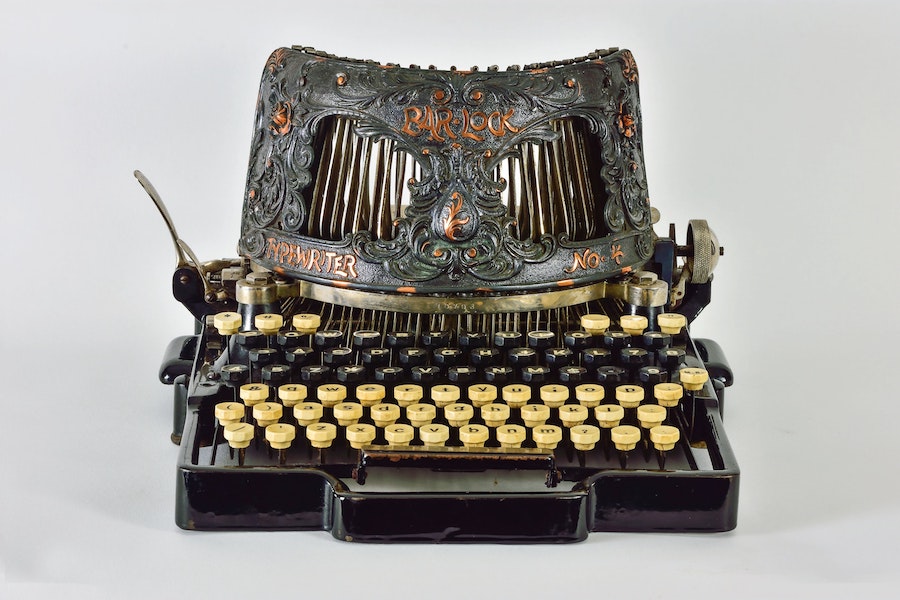A look back at the most beautiful typewriters ever made
They may be outdated and rarely used, but these machines will live on in design history. Claire Spreadbury finds out more.
Technology amazes us every single day. And a lot of it does look pretty cool, but it’s no competition for some of the magnificent machinery of our past.
Take the humble typewriter. An outdated piece of kit overtaken by the efficiency of technological advances of computers – but they look so great, you’d happily display a battered and broken one as part of your home decor.
Here are some of our favourite typewriter designs from the last 150 years…
1874: The Sholes & Glidden Type Writer

The Sholes & Glidden Type Writer has the distinction of being the first commercially successful typewriter. Christopher Latham Sholes and Carlos Glidden, with assistance from a team of inventors and promoters, are credited with inventing the machine and bringing it to market.
It was manufactured by E. Remington and Sons, an arms and sewing machine manufacturer in Ilion, New York. The Type Writer, as it was first called, was the landmark invention that helped transform business communication and industry in the late-19th century. Advertised as “a machine now superseding the pen”, the Sholes & Glidden Type Writer is ornately decorated with patriotic banners, flowers, images of young women, and landscapes. It types in uppercase characters only and is a blind writer, meaning you cannot see what is being typed. The user must raise the carriage up on its hinges to view their work.
It was on the Sholes & Glidden Type Writer that the QWERTY keyboard, the same keyboard arrangement in use today, made its first appearance. The Sholes & Glidden uses a spooled ribbon for inking, and a bell to sound the end of a writing line. Both were innovative features that became standard hardware on other typewriters for many years to follow. There were around four thousand units manufactured and sold during its four years of production.
1887: The Crandall New Model

The Crandall New Model typewriter was invented by Lucien S. Crandall and is considered by many to be one of the most beautiful typewriters ever manufactured. It was designed by the Crandall Machine Company in Groton, New York, and was heavily decorated in the style of the Victorian era. Virtually every inch of its black paint is covered in gold scrollwork, painted flowers, and inlaid mother-of-pearl.
Beyond its elaborate aesthetics, the Crandall introduced a technological innovation not previously seen in a writing machine; a type sleeve – an elongated cylinder with a full set of characters for printing. This design replaced the need for an entire set of typebars. A complex mechanism rotated and lifted the cylinder in order to locate the desired character for printing.
A gracefully arched two-row keyboard displays the characters in a unique arrangement, with two shift keys centred above the top row. A delicate front frame elegantly encases the keyboard. The Crandall’s beauty and unique design make it a highly-prized possession for collectors.
1912: The Victor No. 3

The Victor typewriter first appeared on the market in 1907 and derived its name from a distant connection to the Victor Index typewriter of 1889. The Victor was an early entrant into a typewriter industry in the midst of transitioning from blind understrike to visible writing. This was the first major design improvement since the shift key that provided upper and lowercase typing was introduced in 1878; it marked an exciting chapter in typewriter history. This model became the company’s bestseller.
The Victor No. 3 is a full-size, fully featured, visible typewriter with a four-bank keyboard. The typebars are each mounted on a fork-like pivot that is adjustable as the typebars degrade from mechanical wear, thus insuring proper type alignment as the machine ages. A ribbon selector lever above the keyboard permits a typist to switch between black and red ink, by laterally shifting the entire ribbon assembly.
A light touch, superior print quality, and host of other features were no match for the fierce competition that existed between numerous typewriter brands competing in a crowded field during this period. The Victor achieved only moderate success and lingered on until 1925, when the company failed and its assets were dissolved
1917: The Noiseless

As the typewriter gained in popularity and its use in business increased, the need to maintain a quiet workplace became a concern. While the sound produced by a single typewriter in an office might be tolerable, placing several in a room could result in a more unpleasant noise level. The Noiseless typewriter was developed to address this issue.
The Noiseless incorporates one of the more complex printing mechanisms found in a typewriter – a method adapted from the technique a printing press uses to press its type into paper. Its aim is to press with a precise impact, reducing the noise created by the excessive force of a typebar striking the platen. A steel platen provides the hard surface needed for printing with less force than conventional methods.
The Noiseless Typewriter Company began limited production of their typewriter in 1912 and continued making improvements over a five-year period, until it was ready for large-scale manufacturing in 1917. The design worked well and was extremely successful in the market. In 1924, the Noiseless Typewriter Company was purchased by Remington, who added their name to the brand and continued with its production for several decades to follow.
1955: The Royal Quiet DeLuxe

The Royal Quiet DeLuxe of 1955 is the result of a post–World War II makeover of an original design, dating back almost two decades earlier. When first introduced in 1939, the Quiet DeLuxe included premium features, such as a touch control to adjust keyboard pressure, and Royal’s newly-patented and trademarked Magic Margin; margins that reposition themselves with the touch of a button. Yet, the Quiet DeLuxe presented itself in a dreary, dark, textured finish.
In 1944, World War II caused a two-year halt in typewriter manufacturing, but when production resumed, in an optimistic post-war environment, the Quiet DeLuxe underwent a series of changes that would prove its best days were yet to come.
The post-war Quiet DeLuxe received two body style updates, but its most noticeable change came in 1955, when a variety of bright pastel colour options were unveiled. A soft cream-coloured keyboard transformed it into one of the more remarkable-looking typewriters of its era.
1969: The Olivetti Valentine

The Olivetti Valentine typewriter was an extreme makeover of an earlier model, known as the Lettera 32. Its merits as a typewriter might go unnoticed if it weren’t for its bright red modern body design, created by noted Italian designer Ettore Sottsass and British designer Perry King. This avant-garde appearance, coupled with a brilliant marketing campaign by Olivetti, was the key to success for the Valentine.
Magazine advertisements called it ‘Valentine, the brightwriter – Olivetti’s newest anti-establishment portable’. In an era of social unrest, the mood among many was subversive, and the Valentine fit with the spirit of the times. It challenged the conventional notion that a typewriter only needed to be functional.
A handle attached to the rear of the typewriter provided a means for carrying the Valentine, and its exciting look found a place with the youth culture of the 1960s. Today, it’s a symbol of modern design and 1960s pop culture, with exhibits in museums around the world. The Valentine is a favourite with typewriter collectors – and may be more popular today than when it was first introduced in 1969.

Typewriters: Iconic Machines From The Golden Age Of Mechanical Writing by Anthony Casillo, photography by Bruce Curtis and Anthony Casillo, is published by Chronicle Books, priced £30. Available now.
The Press Association
Latest posts by The Press Association (see all)
- World Penguin Day: Test your knowledge with our penguin-themed quiz - April 23, 2024
- Kate’s new photo of Louis released to celebrate prince’s sixth birthday - April 23, 2024
- Alan Titchmarsh: Slugs are never going to be my friends - April 23, 2024
- Prince Louis celebrates sixth birthday - April 23, 2024
- Special episode of Planet Earth III to be narrated by schoolchildren - April 22, 2024






















